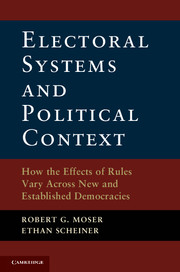 Electoral Systems and Political Context
Electoral Systems and Political Context Book contents
- Frontmatter
- Contents
- Tables and Figures
- Abbreviations
- Glossary of Key Terms
- Acknowledgments and Note on the Online Appendix
- Introduction
- 1 When Do the Effects of Electoral Systems Diverge from Our Expectations?
- 2 Mixed-Member Electoral Systems
- 3 How Democratic Experience and Party System Development Condition the Effects of Electoral Rules on Disproportionality and the Number of Parties
- 4 How Democratic Experience and Party System Development Condition the Effects of Electoral Rules on Disproportionality and the Number of Parties
- 5 Political Context, Electoral Rules, and Their Effects on Strategic and Personal Voting
- 6 How Democratic Experience and Party System Development Condition the Effect of Electoral Rules on Strategic Defection
- 7 Social Diversity, Electoral Rules, and the Number of Parties
- 8 How Political Context Shapes the Effect of Electoral Rules on Women's Representation
- 9 Conclusion
- References
- Index
8 - How Political Context Shapes the Effect of Electoral Rules on Women's Representation
Published online by Cambridge University Press: 05 November 2012
- Frontmatter
- Contents
- Tables and Figures
- Abbreviations
- Glossary of Key Terms
- Acknowledgments and Note on the Online Appendix
- Introduction
- 1 When Do the Effects of Electoral Systems Diverge from Our Expectations?
- 2 Mixed-Member Electoral Systems
- 3 How Democratic Experience and Party System Development Condition the Effects of Electoral Rules on Disproportionality and the Number of Parties
- 4 How Democratic Experience and Party System Development Condition the Effects of Electoral Rules on Disproportionality and the Number of Parties
- 5 Political Context, Electoral Rules, and Their Effects on Strategic and Personal Voting
- 6 How Democratic Experience and Party System Development Condition the Effect of Electoral Rules on Strategic Defection
- 7 Social Diversity, Electoral Rules, and the Number of Parties
- 8 How Political Context Shapes the Effect of Electoral Rules on Women's Representation
- 9 Conclusion
- References
- Index
Summary
In this chapter, we turn our attention away from strategic defection by voters and elites and the number of parties under plurality rules to focus on the types of people who win office in democratic elections. More specifically, we explore how political context conditions the impact of electoral rules on the election of women to legislative office.
The election of women to public office is inherently important. Intuitively, female representation offers symbolic benefits for gender equality (see Phillips 1995), and there is evidence that female legislators behave differently from their male counterparts (Mansbridge 1999; Bratton and Ray 2002). It is therefore noteworthy that electoral systems are important in shaping the degree to which women win elected office. Significant research indicates that larger shares of women gain office under closed-list proportional representation rules than in single-member districts, but this finding is more consistent in consolidated democracies than in new ones.
The literature implicitly highlights two features of PR that especially help women’s representation. First, the closed-list party vote in many PR systems would appear to help women over the more candidate-centered balloting under SMDs: compared with the process by which candidates are nominated for SMD races, national party leaders appear more inclined to nominate women, so closed party lists and centralized party nomination processes are seen as more conducive to women’s representation (Norris 1993; Valdini 2005, 2006). Moreover, some voters may not wish to vote for a woman under SMD rules when they cast their ballots for individual candidates, but see no problem with casting a ballot for a list that includes women under PR where they vote for a party. Second, the higher district magnitudes of PR systems also appear to offer women a better shot at election than single-member districts (especially FPTP) by lowering the effective threshold (i.e., the share of the vote) necessary for election.
- Type
- Chapter
- Information
- Electoral Systems and Political ContextHow the Effects of Rules Vary Across New and Established Democracies, pp. 208 - 235Publisher: Cambridge University PressPrint publication year: 2012
- 1
- Cited by


